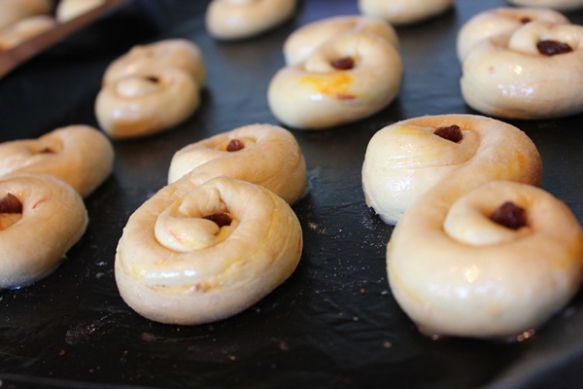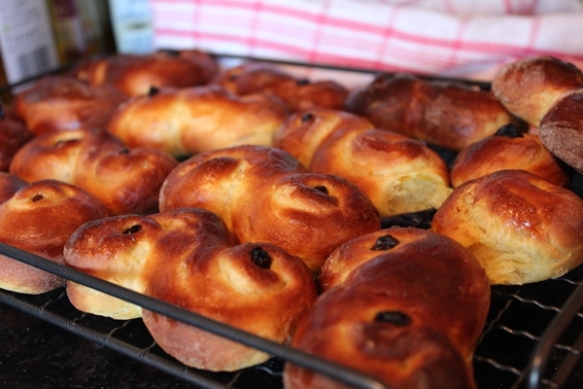Yesterday was Saint Lucia’s Day, a day that although it’s not a public holiday, is widely celebrated in Sweden as if it is. I did try to pen a description of what Lucia is {apart from a Sicilian saint}, but very quickly started stumbling as a lot of what I take for granted when it comes to this very traditional celebration, sounded somewhat ridiculous when writing it down. I will suffice to mention a few key points: white gowns, bearers of light, singing, saffron buns, star boys {see, this is where it starts sounding odd!!}
Instead, I leave you with this little tongue in cheek film which, although still making it sound somewhat ridiculous, makes a better attempt of describing how it’s celebrated in Sweden than my feeble endeavor – Lucia for Dummies
Swiftly moving on to my main reason for this post – Lussekatter, or saffron buns. The literal translation of the word is actually Lucia’s cats {hence my ramblings above}. I’m not entirely sure why they are called that, some sources seem to suggest it’s because the buns are shaped like cats, but to me the most traditional shape of the bun is more like an S than a cat. Either way, they are usually eaten around Christmas, and particularly Saint Lucia’s Day.

I use quark in mine, which is supposed to keep them fresher and more succulent. Quark is a type of cheese, similar to cottage cheese, but comes ‘solid’ in a tub, unlike cottage cheese which has a broken up texture. It is usually found in the cheese isle in the supermarket. I’m not sure if it actually helps keeping them more succulent as I always put any that don’t get eaten straight away into the freezer once they have cooled, as I find that the best way of keeping them fresh. And they taste freshly baked if reheating them a little when taking them out of the freezer, which makes them all the more lovely! 
The most traditional shape of the buns is, as mentioned earlier, the S shape, decorated with raisins in the bend of each S. There are however a number of different other shapes, {of varying difficulty} that are common as well. I found a beautiful hand-drawn picture of some of them on this lovely blog – Receptfavoriter.
I have also been known to just roll the dough out and cutting different shapes out of it with a large cookie cutter, stars or hearts for example. Just mind the cooking time if you do, as the flatter dough tend to bake faster.
Lussekatter / Saffron buns
Ingredients
500 ml milk
1 g saffron
100 g butter
2 sachets of fast action dried yeast
250 g quark
150 ml sugar
1/2 teaspoon salt
about 1.5 liter flour
Decoration
raisins
1 egg
Method
1) Pour the milk into a saucepan and add the saffron strands. Warm until lukewarm
2) Melt the butter
3) Add the flour, yeast, sugar and salt to a mixing bowl, pour in the milk, butter and quark and knead the dough until smooth.
4) Cover the mixing bowl with a clean a tea towel and leave to rise for about 1 hour, or until doubled in size. .
5) Preheat the oven to 225 °.
6) Put the dough onto a floured work surface and divide it into small pieces, shaping them into S shapes.
7) Place on baking trays, decorate with raisins and leave to rise for about 20 minutes.
8) Brush with beaten egg then bake in middle of oven 5-8 minutes.
9) Let cool on a rack.

